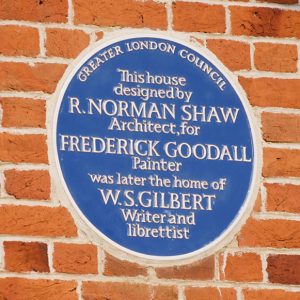 When you stand outside the main entrance at Grim’s Dyke, look to the left and you’ll see a familiar blue plaque. This historical marker usually commemorates the link between the location and a famous person – although in Grim’s Dyke’s case, our historical marker commemorates not one person, but three!
When you stand outside the main entrance at Grim’s Dyke, look to the left and you’ll see a familiar blue plaque. This historical marker usually commemorates the link between the location and a famous person – although in Grim’s Dyke’s case, our historical marker commemorates not one person, but three!
In 1976 The Greater London Council issued Grim’s Dyke with the traditional ceramic blue plaque to commemorate Architect Richard Norman Shaw (1831-1912), painter Frederick Goodall (1822-1904) and writer and librettist Sir W.S. Gilbert (1836-1911). It’s one of the four plaques in the London Borough of Harrow.
But what about the history of the blue plaques themselves?
The blue plaque scheme
Originally the blue plaque scheme was founded in 1866 by William Ewart, Henry Cole and the Society of Arts. The first plaque was unveiled in 1867 to commemorate Lord Byron at his birthplace in Cavendish Square. The Society of Arts put up only 35 plaques in total, before the scheme was taken over by London County Council in 1901.
In 1965 the Greater London Council (GLC) took over, once the LCC was abolished. The GLC erected a total of 252 plaques. It was all change again in 1986, when the GLC was disbanded and the scheme passed to English Heritage. During this time, 300 more plaques were erected.
Following a brief suspension in 2013, due to funding cuts, the scheme was relaunched in 2014 with private funding. The scheme was briefly funded by a new donor’s club – the Blue Plaques Club and property developer David Pearl – before being passed to the English Heritage Trust.
The changing face of the scheme
During its lifetime, the blue plaque has had many shapes, styles and colours – even going chocolate brown, in an effort to save money! It’s had laurel leaves, white borders, no borders and, finally the uniform style that was agreed in 1938 – after the committee approved an unnamed scholar at the LCC’s Central School of Arts and Crafts new design.
But it’s not just the style that was altered over the years – the material did too. During the 1920’s experimentation included using bronze, stone and lead plaques. In 1921 the blue encaustic tile was finally replaced with the cheaper glazed ceramic Doulton ware plaque.
We feel immensely proud to be a part of this historical commemorative scheme, especially as proposals for English Heritage plaques are made by members of the public and only 1/3 of all proposals are approved in principle to go on a shortlist, by the 9-strong panel. It can then take another 3 years to reach the top of that shortlist. For those that are unsuccessful, they can reapply – once 10 years have elapsed!

